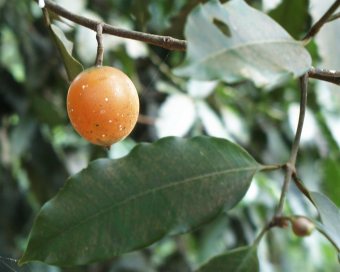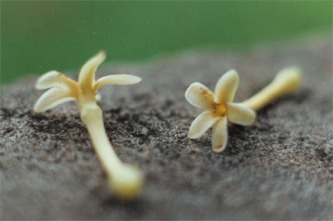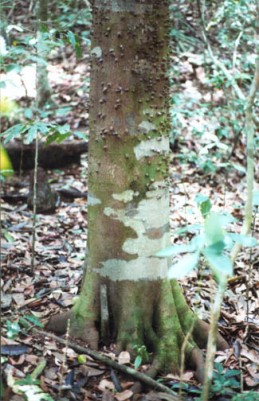Lacmellea panamensis (Woodson) Markgr.
Apocynaceae CERILLO, ESPINUDO, LAGARTO NEGRO
Occasional evergreen understory or rarely subcanopy tree (15-20 m) found growing under a variety of conditions, but especially within the semi-darkness of the dense, primary forest. Covered with broad-based, conical thorns in a way seldom seen among lowland trees, Lacmellea is a distinctive species, whose thick, bright green crown is frequently studded with round, yellow fruits and tubular, white flowers.
 Description: A small to medium sized tree, Lacmellea has a straight and cylindrical (truly columnar) trunk that may reach 40 cm in diameter. Larger trees may also sport low, rounded, and short buttresses that barely widen the base of the bole. Clad in smooth, gray-brown bark, the trunk is frequently mottled by colonies of flat, blue-gray lichens that seem to prefer this species. All Lacmellea surfaces exude large amounts of thick, white latex when broken. Along the upper third of its length, the monopodial-like trunk gives rise to many, relatively short, thin branches that leave the bole horizontally but then droop under their own weight. The crown they produce is at once narrow and moderately thick. Simple and opposite, Lacmellea leaves (12 cm by 4.5 cm) are narrowly elliptical in shape. Each glossy, light green blade bares a contrasting pattern of yellow, pinnately arranged leaf veins. Flexible and soft as well, the blade is supported by 1 cm petiole and ends in a 1 cm drip-tip. Most new foliage is generated from branch tips in December and January. Flowers (3.5 cm by 1 cm) appear in small, axillary cymes bearing from one to six blossoms each. Based in a cup-like, five-point, green calyx, a long, creme-colored tubular corolla (3.5 cm) dominates each blossom. This corolla sports two marked swellings: one at its base and the other two-thirds the way along its length. Just past this second swelling, the corolla flares into five, yellowish and finger-
Description: A small to medium sized tree, Lacmellea has a straight and cylindrical (truly columnar) trunk that may reach 40 cm in diameter. Larger trees may also sport low, rounded, and short buttresses that barely widen the base of the bole. Clad in smooth, gray-brown bark, the trunk is frequently mottled by colonies of flat, blue-gray lichens that seem to prefer this species. All Lacmellea surfaces exude large amounts of thick, white latex when broken. Along the upper third of its length, the monopodial-like trunk gives rise to many, relatively short, thin branches that leave the bole horizontally but then droop under their own weight. The crown they produce is at once narrow and moderately thick. Simple and opposite, Lacmellea leaves (12 cm by 4.5 cm) are narrowly elliptical in shape. Each glossy, light green blade bares a contrasting pattern of yellow, pinnately arranged leaf veins. Flexible and soft as well, the blade is supported by 1 cm petiole and ends in a 1 cm drip-tip. Most new foliage is generated from branch tips in December and January. Flowers (3.5 cm by 1 cm) appear in small, axillary cymes bearing from one to six blossoms each. Based in a cup-like, five-point, green calyx, a long, creme-colored tubular corolla (3.5 cm) dominates each blossom. This corolla sports two marked swellings: one at its base and the other two-thirds the way along its length. Just past this second swelling, the corolla flares into five, yellowish and finger- like petals. An equal number of stamens are attached to the corolla, though hidden from view within it. Sporadic flowers may appear at any time during the year but the most intense and synchronized blossoming is confined to the months from February to April. Fruits (4 cm) are rounded – nearly spherical – drupes, often ending in sharp, distal points. Initially green and glossy, many of them begin to accumulate in the Lacmellea crown after flowering, reaching full size quickly and persisting there for many months before ripening. Slowly and individually, the fruits turn bright yellow and fall from the trees. Inside each, a thick layer of soft flesh surrounds two seeds. Though not all individuals within a given population participate, many trees possess large numbers of fruits all year long, harvesting continuously – but slowly – throughout this time.
like petals. An equal number of stamens are attached to the corolla, though hidden from view within it. Sporadic flowers may appear at any time during the year but the most intense and synchronized blossoming is confined to the months from February to April. Fruits (4 cm) are rounded – nearly spherical – drupes, often ending in sharp, distal points. Initially green and glossy, many of them begin to accumulate in the Lacmellea crown after flowering, reaching full size quickly and persisting there for many months before ripening. Slowly and individually, the fruits turn bright yellow and fall from the trees. Inside each, a thick layer of soft flesh surrounds two seeds. Though not all individuals within a given population participate, many trees possess large numbers of fruits all year long, harvesting continuously – but slowly – throughout this time.
 Similar Species: With its thorned trunk and oppositely arranged leaves, Lacmellea should not be confused with any other tree present in Manuel Antonio. Fruits, present year round in most individuals, should further aid in the identification of this species.
Similar Species: With its thorned trunk and oppositely arranged leaves, Lacmellea should not be confused with any other tree present in Manuel Antonio. Fruits, present year round in most individuals, should further aid in the identification of this species.
Natural History: The precise role of trunk thorns like those possessed by Lacmellea is open to speculation. Not sharp nor abundant enough to prevent small mammals (e.g. squirrels, tyras, coatis) from climbing the bole, they may have once served to deter heavier species. Leaf-eating giant ground sloths, extinct for the last 10,000 years, were once present in these woods, and Lacmellea‘s thorns may have been intended to keep them from scaling the boles to browse its foliage. If this indeed was their purpose, the thorns would no longer confer any advantage to the trees that possess them, and one might expect to eventually see thornless Lacmellea trees appearing in the forest. Indeed, a similar process may well be exemplified by Bombacopsis quinata (Pochote), a dry forest tree sporting similar thorns to those of Lacmellea. Certain individuals seen growing in the Nicoya Peninsula’s Curu reserve are indeed spineless.
Croat (1978) suggests that Lacmellea‘s deeply-necked flowers are pollinated by long-tongued bees, butterflies and hawkmoths. He says howler monkeys consume the fruits while sloths appear to be particularly fond of Lacmellea foliage.
Uses: Allen (1956) reports that the latexes of several South American species of Lacmellea have been used as chewing gum, as an additive to rubber, and as a milk substitute in coffee
Distribution: Lacmellea is found in primary forests on well drained soils. The species is common in the parks and reserves along Costa Rica’s southern Pacific slope (from Carara to Corcovado). It ranges from Belize to Panama.
